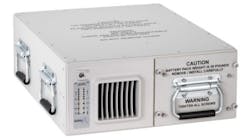Rugged embedded computer with boot-kick display introduced by GMS for military and avionics applications
The display has a wide viewing angle, an LED backlight, boot-kick/EMI screen protection, and is sealed from water, dust, and other contaminants. The coated and etched glass overlay provides avionics-grade quality.
Options include five USB-2.0 ports; four SATA ports; four RS232/422/485 ports; eight buffered or unbuffered general I/O lines; x16XMC, x1XMC (or 100MHz/64bit PMC-X sites with PIM or dual Mini PCI sites); and three Express Mini sites.
Secure erase and data encryption on drives help protect against software-based attacks. Rugged, conduction-cooled versions with display operate in temperatures from -20 to 70 degrees Celsius, while non-display versions operate in temperatures from -40 to 85 C. The computers comply to MIL-STD-810G, MIL-STD-704E, and MIL-STD-461F.
Software support includes Windows XP/XPE/7, Linux, and VxWorks. For more information contact General Micro Systems online at www.gms4sbc.com.
